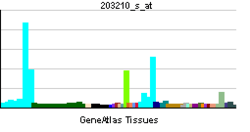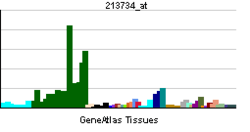RFC5
Replication factor C subunit 5 is a protein that in humans is encoded by the RFC5 gene.[1][2]
The elongation of primed DNA templates by DNA polymerase delta and DNA polymerase epsilon requires the accessory proteins proliferating cell nuclear antigen (PCNA) and replication factor C (RFC). RFC, also named activator 1, is a protein complex consisting of five distinct subunits of 140, 40, 38, 37, and 36 kD. This gene encodes the 36 kD subunit. This subunit can interact with the C-terminal region of PCNA. It forms a core complex with the 38 and 40 kDa subunits. The core complex possesses DNA-dependent ATPase activity, which was found to be stimulated by PCNA in an in vitro system. Alternatively spliced transcript variants encoding distinct isoforms have been reported.[2]
Interactions
RFC5 has been shown to interact with BRD4,[3] RFC2,[4][5] PCNA,[4][6][7] RFC4[4][5][8][9] and CHTF18.[10]
References
- ↑ Okumura K, Nogami M, Taguchi H, Dean FB, Chen M, Pan ZQ, Hurwitz J, Shiratori A, Murakami Y, Ozawa K et al. (Jul 1995). "Assignment of the 36.5-kDa (RFC5), 37-kDa (RFC4), 38-kDa (RFC3), and 40-kDa (RFC2) subunit genes of human replication factor C to chromosome bands 12q24.2-q24.3, 3q27, 13q12.3-q13, and 7q11.23". Genomics 25 (1): 274–8. doi:10.1016/0888-7543(95)80135-9. PMID 7774928.
- ↑ 2.0 2.1 "Entrez Gene: RFC5 replication factor C (activator 1) 5, 36.5kDa".
- ↑ Maruyama, Tetsuo; Farina Andrea; Dey Anup; Cheong JaeHun; Bermudez Vladimir P; Tamura Tomohiko; Sciortino Selvaggia; Shuman Jon; Hurwitz Jerard; Ozato Keiko (Sep 2002). "A Mammalian bromodomain protein, brd4, interacts with replication factor C and inhibits progression to S phase". Mol. Cell. Biol. (United States) 22 (18): 6509–20. doi:10.1128/MCB.22.18.6509-6520.2002. ISSN 0270-7306. PMC 135621. PMID 12192049.
- ↑ 4.0 4.1 4.2 Cai, J; Gibbs E; Uhlmann F; Phillips B; Yao N; O'Donnell M; Hurwitz J (Jul 1997). "A complex consisting of human replication factor C p40, p37, and p36 subunits is a DNA-dependent ATPase and an intermediate in the assembly of the holoenzyme". J. Biol. Chem. (UNITED STATES) 272 (30): 18974–81. doi:10.1074/jbc.272.30.18974. ISSN 0021-9258. PMID 9228079.
- ↑ 5.0 5.1 Cai, J; Yao N; Gibbs E; Finkelstein J; Phillips B; O'Donnell M; Hurwitz J (Sep 1998). "ATP hydrolysis catalyzed by human replication factor C requires participation of multiple subunits". Proc. Natl. Acad. Sci. U.S.A. (UNITED STATES) 95 (20): 11607–12. doi:10.1073/pnas.95.20.11607. ISSN 0027-8424. PMC 21688. PMID 9751713.
- ↑ Mossi, R; Jónsson Z O; Allen B L; Hardin S H; Hübscher U (Jan 1997). "Replication factor C interacts with the C-terminal side of proliferating cell nuclear antigen". J. Biol. Chem. (UNITED STATES) 272 (3): 1769–76. doi:10.1074/jbc.272.3.1769. ISSN 0021-9258. PMID 8999859.
- ↑ Ohta, Satoshi; Shiomi Yasushi; Sugimoto Katsunori; Obuse Chikashi; Tsurimoto Toshiki (Oct 2002). "A proteomics approach to identify proliferating cell nuclear antigen (PCNA)-binding proteins in human cell lysates. Identification of the human CHL12/RFCs2-5 complex as a novel PCNA-binding protein". J. Biol. Chem. (United States) 277 (43): 40362–7. doi:10.1074/jbc.M206194200. ISSN 0021-9258. PMID 12171929.
- ↑ Rual, Jean-François; Venkatesan Kavitha, Hao Tong, Hirozane-Kishikawa Tomoko, Dricot Amélie, Li Ning, Berriz Gabriel F, Gibbons Francis D, Dreze Matija, Ayivi-Guedehoussou Nono, Klitgord Niels, Simon Christophe, Boxem Mike, Milstein Stuart, Rosenberg Jennifer, Goldberg Debra S, Zhang Lan V, Wong Sharyl L, Franklin Giovanni, Li Siming, Albala Joanna S, Lim Janghoo, Fraughton Carlene, Llamosas Estelle, Cevik Sebiha, Bex Camille, Lamesch Philippe, Sikorski Robert S, Vandenhaute Jean, Zoghbi Huda Y, Smolyar Alex, Bosak Stephanie, Sequerra Reynaldo, Doucette-Stamm Lynn, Cusick Michael E, Hill David E, Roth Frederick P, Vidal Marc (Oct 2005). "Towards a proteome-scale map of the human protein-protein interaction network". Nature (England) 437 (7062): 1173–8. doi:10.1038/nature04209. PMID 16189514.
- ↑ Ellison, V; Stillman B (Mar 1998). "Reconstitution of recombinant human replication factor C (RFC) and identification of an RFC subcomplex possessing DNA-dependent ATPase activity". J. Biol. Chem. (UNITED STATES) 273 (10): 5979–87. doi:10.1074/jbc.273.10.5979. ISSN 0021-9258. PMID 9488738.
- ↑ Bermudez, Vladimir P; Maniwa Yoshimasa; Tappin Inger; Ozato Keiko; Yokomori Kyoko; Hurwitz Jerard (Sep 2003). "The alternative Ctf18-Dcc1-Ctf8-replication factor C complex required for sister chromatid cohesion loads proliferating cell nuclear antigen onto DNA". Proc. Natl. Acad. Sci. U.S.A. (United States) 100 (18): 10237–42. doi:10.1073/pnas.1434308100. ISSN 0027-8424. PMC 193545. PMID 12930902.
Further reading
- O'Donnell M, Onrust R, Dean FB et al. (1993). "Homology in accessory proteins of replicative polymerases--E. coli to humans.". Nucleic Acids Res. 21 (1): 1–3. doi:10.1093/nar/21.1.1. PMC 309057. PMID 8441605.
- Uhlmann F, Cai J, Flores-Rozas H et al. (1996). "In vitro reconstitution of human replication factor C from its five subunits.". Proc. Natl. Acad. Sci. U.S.A. 93 (13): 6521–6. doi:10.1073/pnas.93.13.6521. PMC 39056. PMID 8692848.
- Mossi R, Jónsson ZO, Allen BL et al. (1997). "Replication factor C interacts with the C-terminal side of proliferating cell nuclear antigen.". J. Biol. Chem. 272 (3): 1769–76. doi:10.1074/jbc.272.3.1769. PMID 8999859.
- Cujec TP, Cho H, Maldonado E et al. (1997). "The human immunodeficiency virus transactivator Tat interacts with the RNA polymerase II holoenzyme.". Mol. Cell. Biol. 17 (4): 1817–23. PMC 232028. PMID 9121429.
- Cai J, Gibbs E, Uhlmann F et al. (1997). "A complex consisting of human replication factor C p40, p37, and p36 subunits is a DNA-dependent ATPase and an intermediate in the assembly of the holoenzyme.". J. Biol. Chem. 272 (30): 18974–81. doi:10.1074/jbc.272.30.18974. PMID 9228079.
- Loor G, Zhang SJ, Zhang P et al. (1998). "Identification of DNA replication and cell cycle proteins that interact with PCNA.". Nucleic Acids Res. 25 (24): 5041–6. doi:10.1093/nar/25.24.5041. PMC 147130. PMID 9396813.
- Ellison V, Stillman B (1998). "Reconstitution of recombinant human replication factor C (RFC) and identification of an RFC subcomplex possessing DNA-dependent ATPase activity.". J. Biol. Chem. 273 (10): 5979–87. doi:10.1074/jbc.273.10.5979. PMID 9488738.
- Cai J, Yao N, Gibbs E et al. (1998). "ATP hydrolysis catalyzed by human replication factor C requires participation of multiple subunits.". Proc. Natl. Acad. Sci. U.S.A. 95 (20): 11607–12. doi:10.1073/pnas.95.20.11607. PMC 21688. PMID 9751713.
- Zhang G, Gibbs E, Kelman Z et al. (1999). "Studies on the interactions between human replication factor C and human proliferating cell nuclear antigen.". Proc. Natl. Acad. Sci. U.S.A. 96 (5): 1869–74. doi:10.1073/pnas.96.5.1869. PMC 26703. PMID 10051561.
- Lindsey-Boltz LA, Bermudez VP, Hurwitz J, Sancar A (2001). "Purification and characterization of human DNA damage checkpoint Rad complexes.". Proc. Natl. Acad. Sci. U.S.A. 98 (20): 11236–41. doi:10.1073/pnas.201373498. PMC 58713. PMID 11572977.
- Griffith JD, Lindsey-Boltz LA, Sancar A (2002). "Structures of the human Rad17-replication factor C and checkpoint Rad 9-1-1 complexes visualized by glycerol spray/low voltage microscopy.". J. Biol. Chem. 277 (18): 15233–6. doi:10.1074/jbc.C200129200. PMID 11907025.
- Ohta S, Shiomi Y, Sugimoto K et al. (2002). "A proteomics approach to identify proliferating cell nuclear antigen (PCNA)-binding proteins in human cell lysates. Identification of the human CHL12/RFCs2-5 complex as a novel PCNA-binding protein.". J. Biol. Chem. 277 (43): 40362–7. doi:10.1074/jbc.M206194200. PMID 12171929.
- Maruyama T, Farina A, Dey A et al. (2002). "A Mammalian bromodomain protein, brd4, interacts with replication factor C and inhibits progression to S phase.". Mol. Cell. Biol. 22 (18): 6509–20. doi:10.1128/MCB.22.18.6509-6520.2002. PMC 135621. PMID 12192049.
- Venclovas C, Colvin ME, Thelen MP (2003). "Molecular modeling-based analysis of interactions in the RFC-dependent clamp-loading process.". Protein Sci. 11 (10): 2403–16. doi:10.1110/ps.0214302. PMC 2373712. PMID 12237462.
- Strausberg RL, Feingold EA, Grouse LH et al. (2003). "Generation and initial analysis of more than 15,000 full-length human and mouse cDNA sequences.". Proc. Natl. Acad. Sci. U.S.A. 99 (26): 16899–903. doi:10.1073/pnas.242603899. PMC 139241. PMID 12477932.
- Merkle CJ, Karnitz LM, Henry-Sánchez JT, Chen J (2003). "Cloning and characterization of hCTF18, hCTF8, and hDCC1. Human homologs of a Saccharomyces cerevisiae complex involved in sister chromatid cohesion establishment.". J. Biol. Chem. 278 (32): 30051–6. doi:10.1074/jbc.M211591200. PMID 12766176.
- Bermudez VP, Maniwa Y, Tappin I et al. (2003). "The alternative Ctf18-Dcc1-Ctf8-replication factor C complex required for sister chromatid cohesion loads proliferating cell nuclear antigen onto DNA.". Proc. Natl. Acad. Sci. U.S.A. 100 (18): 10237–42. doi:10.1073/pnas.1434308100. PMC 193545. PMID 12930902.
- Zou L, Liu D, Elledge SJ (2004). "Replication protein A-mediated recruitment and activation of Rad17 complexes.". Proc. Natl. Acad. Sci. U.S.A. 100 (24): 13827–32. doi:10.1073/pnas.2336100100. PMC 283506. PMID 14605214.
- Ota T, Suzuki Y, Nishikawa T et al. (2004). "Complete sequencing and characterization of 21,243 full-length human cDNAs.". Nat. Genet. 36 (1): 40–5. doi:10.1038/ng1285. PMID 14702039.


